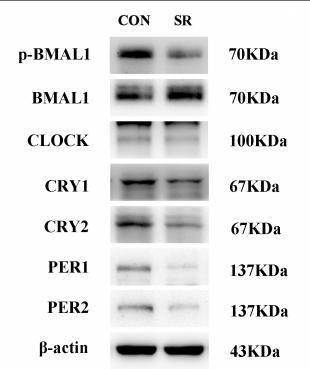Phospho-IRS2 (Ser1100) Antibody - #AF8383
| Product: | Phospho-IRS2 (Ser1100) Antibody |
| Catalog: | AF8383 |
| Description: | Rabbit polyclonal antibody to Phospho-IRS2 (Ser1100) |
| Application: | WB IHC IF/ICC |
| Cited expt.: | WB |
| Reactivity: | Human, Mouse |
| Prediction: | Dog |
| Mol.Wt.: | 137kDa; 137kD(Calculated). |
| Uniprot: | Q9Y4H2 |
| RRID: | AB_2840444 |
Related Downloads
Protocols
Product Info
*The optimal dilutions should be determined by the end user. For optimal experimental results, antibody reuse is not recommended.
*Tips:
WB: For western blot detection of denatured protein samples. IHC: For immunohistochemical detection of paraffin sections (IHC-p) or frozen sections (IHC-f) of tissue samples. IF/ICC: For immunofluorescence detection of cell samples. ELISA(peptide): For ELISA detection of antigenic peptide.
Cite Format: Affinity Biosciences Cat# AF8383, RRID:AB_2840444.
Fold/Unfold
Insulin receptor substrate 2; IRS 2; IRS-2; Irs2; IRS2_HUMAN;
Immunogens
A synthesized peptide derived from human IRS2 around the phosphorylation site of Ser1100.
- Q9Y4H2 IRS2_HUMAN:
- Protein BLAST With
- NCBI/
- ExPASy/
- Uniprot
MASPPRHGPPGPASGDGPNLNNNNNNNNHSVRKCGYLRKQKHGHKRFFVLRGPGAGGDEATAGGGSAPQPPRLEYYESEKKWRSKAGAPKRVIALDCCLNINKRADAKHKYLIALYTKDEYFAVAAENEQEQEGWYRALTDLVSEGRAAAGDAPPAAAPAASCSASLPGALGGSAGAAGAEDSYGLVAPATAAYREVWQVNLKPKGLGQSKNLTGVYRLCLSARTIGFVKLNCEQPSVTLQLMNIRRCGHSDSFFFIEVGRSAVTGPGELWMQADDSVVAQNIHETILEAMKALKELFEFRPRSKSQSSGSSATHPISVPGARRHHHLVNLPPSQTGLVRRSRTDSLAATPPAAKCSSCRVRTASEGDGGAAAGAAAAGARPVSVAGSPLSPGPVRAPLSRSHTLSGGCGGRGSKVALLPAGGALQHSRSMSMPVAHSPPAATSPGSLSSSSGHGSGSYPPPPGPHPPLPHPLHHGPGQRPSSGSASASGSPSDPGFMSLDEYGSSPGDLRAFCSHRSNTPESIAETPPARDGGGGGEFYGYMTMDRPLSHCGRSYRRVSGDAAQDLDRGLRKRTYSLTTPARQRPVPQPSSASLDEYTLMRATFSGSAGRLCPSCPASSPKVAYHPYPEDYGDIEIGSHRSSSSNLGADDGYMPMTPGAALAGSGSGSCRSDDYMPMSPASVSAPKQILQPRAAAAAAAAVPSAGPAGPAPTSAAGRTFPASGGGYKASSPAESSPEDSGYMRMWCGSKLSMEHADGKLLPNGDYLNVSPSDAVTTGTPPDFFSAALHPGGEPLRGVPGCCYSSLPRSYKAPYTCGGDSDQYVLMSSPVGRILEEERLEPQATPGPSQAASAFGAGPTQPPHPVVPSPVRPSGGRPEGFLGQRGRAVRPTRLSLEGLPSLPSMHEYPLPPEPKSPGEYINIDFGEPGARLSPPAPPLLASAASSSSLLSASSPASSLGSGTPGTSSDSRQRSPLSDYMNLDFSSPKSPKPGAPSGHPVGSLDGLLSPEASSPYPPLPPRPSASPSSSLQPPPPPPAPGELYRLPPASAVATAQGPGAASSLSSDTGDNGDYTEMAFGVAATPPQPIAAPPKPEAARVASPTSGVKRLSLMEQVSGVEAFLQASQPPDPHRGAKVIRADPQGGRRRHSSETFSSTTTVTPVSPSFAHNPKRHNSASVENVSLRKSSEGGVGVGPGGGDEPPTSPRQLQPAPPLAPQGRPWTPGQPGGLVGCPGSGGSPMRRETSAGFQNGLNYIAIDVREEPGLPPQPQPPPPPLPQPGDKSSWGRTRSLGGLISAVGVGSTGGGCGGPGPGALPPANTYASIDFLSHHLKEATIVKE
Predictions
Score>80(red) has high confidence and is suggested to be used for WB detection. *The prediction model is mainly based on the alignment of immunogen sequences, the results are for reference only, not as the basis of quality assurance.
High(score>80) Medium(80>score>50) Low(score<50) No confidence
Research Backgrounds
May mediate the control of various cellular processes by insulin.
Cytoplasm>Cytosol.
Research Fields
· Cellular Processes > Transport and catabolism > Autophagy - animal. (View pathway)
· Environmental Information Processing > Signal transduction > cGMP-PKG signaling pathway. (View pathway)
· Environmental Information Processing > Signal transduction > FoxO signaling pathway. (View pathway)
· Environmental Information Processing > Signal transduction > AMPK signaling pathway. (View pathway)
· Human Diseases > Endocrine and metabolic diseases > Type II diabetes mellitus.
· Human Diseases > Endocrine and metabolic diseases > Insulin resistance.
· Human Diseases > Endocrine and metabolic diseases > Non-alcoholic fatty liver disease (NAFLD).
· Human Diseases > Cancers: Overview > MicroRNAs in cancer.
· Organismal Systems > Aging > Longevity regulating pathway. (View pathway)
· Organismal Systems > Aging > Longevity regulating pathway - multiple species. (View pathway)
· Organismal Systems > Endocrine system > Insulin signaling pathway. (View pathway)
· Organismal Systems > Endocrine system > Adipocytokine signaling pathway.
· Organismal Systems > Endocrine system > Regulation of lipolysis in adipocytes.
References
Application: WB Species: Human Sample: adipose tissue
Application: WB Species: rat Sample:
Restrictive clause
Affinity Biosciences tests all products strictly. Citations are provided as a resource for additional applications that have not been validated by Affinity Biosciences. Please choose the appropriate format for each application and consult Materials and Methods sections for additional details about the use of any product in these publications.
For Research Use Only.
Not for use in diagnostic or therapeutic procedures. Not for resale. Not for distribution without written consent. Affinity Biosciences will not be held responsible for patent infringement or other violations that may occur with the use of our products. Affinity Biosciences, Affinity Biosciences Logo and all other trademarks are the property of Affinity Biosciences LTD.





